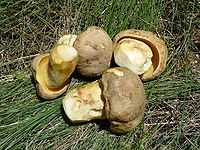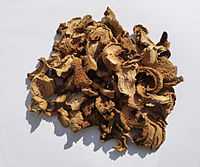Boletus impolitus
| ||||||||||||||||||||||||||||||||||||||||
Boletus impolitus, is a basidiomycete fungus of the Boletaceae family, that has tubes and pores instead of gills. These pores can be seen under the cap as tiny holes. It is edible, but rare, and should not be picked for the table. It grows beneath Quercus (oak) trees. It is commonly called the iodine bolete, because of its smell when cut.
Taxonomy
Impolitus is Latin, meaning "unpolished", "matt", "unsmoothed", or "unfinished", and may be a reference to the hammered look of some specimens. It was first described by Elias Magnus Fries, an eminent mycologist of the 19th century.
Description

The cap is at first hemispherical, but flattens with age, and is sometimes upturned when mature. It is pale brown,light tan, or tawny, often with a pale grey hoariness initially.[1] It often has a 'hammered' look. The cap diameter usually ranges between 5 and 12 cm (2–5 in), but can reach up to 20 cm (8 in). The stem is 5 to 15 cm (2–6 in) high, and is slightly fatter at the base. It is pale yellow, and often has a red flush. It has no network (reticulation), but sometimes has reddish dots.[2] The pores and tubes are pale yellow, with the pores being small and round, and they do 'not' bruise blue. The flesh is pale yellow, and remains the same colour when cut. It is soft and has a sour smell somewhat like iodine in the base. The spore print is olivaceous walnut-brown.[1]
Similar species
- Boletus radicans is very similar, and can also be found with oak. It has a whiter cap, but its pores bruise blue when damaged. It is inedible.
- The bitter and inedible B. calopus has a well-defined network (reticulation), and is redder on the lower part of its stem.
Distribution and habitat
This species is mycorrhizal with oak (Quercus), and occasional in Southern England. In mainland Europe it is found with oaks and hornbeams (Carpinus) on chalky soils, and has been found under pines (Pinus) . In Southern England it can appear in two or three flushes from June till September, depending on weather conditions.
Edibility

Boletus impolitus is typically considered inedible. Some report it as mild, but should be left in the interests of conservation.
